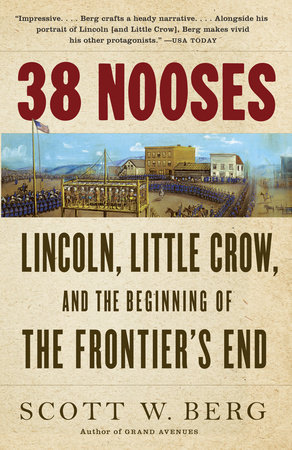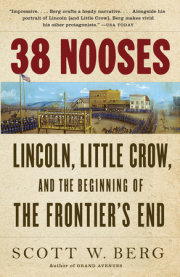Chapter Five
——————
On Thursday, August 21, 1862, the news from Minnesota rode the wires thirteen hundred miles to Washington, D.C., and the telegraph room on the second floor of the War Department building, a few hundred steps across the west lawn of the White House. There it was transcribed and added to a stack of messages in the converted library facing Pennsylvania Avenue that had become a strategic crow’s nest for Abraham Lincoln. The president’s standard practice when awaiting bulletins from various fronts was to wear out the path to the War Department, climb the steps, and look through all of the telegrams. He would keep the messages in order until he stopped, turned to the telegraph operators, and said, “Well, boys, I am down to the raisins.” Borrowed from a doctor ministering to a vomiting child, the metaphor meant that he’d reached a message he’d seen on his previous visit. More than a routine, this was Lincoln’s way of wresting control of the flow of information from his generals and wiring himself directly into the mechanism of the war. Earlier in the year all of the telegraph lines in the North had been placed under the control of the War Department, and since that time keeping up with the wired messages had become an obsession.
The first telegram from Minnesota was addressed from Governor Ramsey to Secretary of War Edwin Stanton. It began, “The Sioux Indians on our western border have risen, and are murdering men, women, and children.” A second message followed hard after, from Minnesota’s secretary of state to Stanton’s assistant war secretary, C. P. Walcott: “A most frightful insurrection of Indians has broken out along our whole frontier. Men, women, and children are indiscriminately murdered; evidently the result of a deep-lain plan, the attacks being simultaneous along our whole border.” Other communications from the frontier would soon follow, all elbowing for room among the business of the Civil War. Dozens of other messages in the pile had arrived this day from every part of the Union, almost all of them concerned with Lincoln’s recent order that the states furnish 300,000 additional troops, asking questions about transport, outfitting, pay, mustering protocols, and timetables. There may have been no worse time during Lincoln’s presidency—or, for that matter, during the nation’s history—to convey such information with any hope of a speedy response.
Thirteen months earlier Lincoln had finished his extraordinary first hundred days in office, shaking off the last lingering sense in the North and South that he was a country bumpkin elevated far above his station. He had turned the shelling of Fort Sumter into a Union rallying cry while managing to keep the border slave states in the fold; he had corralled, if not unified, a seemingly uncorrallable cabinet; and he had created an army and put it into motion across the famous “thousand-mile front” of the Civil War. These developments seemed to be a series of small miracles. Then, in July 1861, naïve and high-spirited Union forces had been routed at Bull Run, just thirty miles southwest of the White House, and cold reality had set in.
Gray and frostbitten February had brought the sudden sickness and death of his favorite son, Willie, after which First Lady Mary Todd descended into a grief so deep and lasting that her husband feared permanent madness was finally setting in. In March the ironclads Monitor and Merrimack had fought their famous battle in Tidewater Virginia, resulting in a standoff that kept the Confederate navy from approaching Washington, D.C., and April had seen Ulysses S. Grant’s important victory at Shiloh. A growing attachment to Tad, his youngest son, began to mend Lincoln’s heart, and as his spirits returned, so did his energy for war: he reorganized and reassigned many of his senior generals, created new military districts, and watched with satisfaction as the Union army headed toward Richmond with 58,000 troops. Early summer was an optimistic time, even for a leader as naturally suspicious of good news as Lincoln, but it was not to last. As the summer of 1862 wore on, Union forces began to founder badly.
n June, Lincoln thought that General George B. McClellan had pinned Robert E. Lee to the ground at Richmond, but over a period of two discouraging weeks the Union forces had reversed direction, first mounting a fruitless siege and then conducting a series of retreats, a defensive strategy based on McClellan’s astounding overestimations of Confederate manpower. Then, as the Northern army sat impotent on Virginia’s James River, the greater portion of Lee’s men headed north along a line that seemed to point straight at the White House. The failure to take Richmond or adequately cover Washington created embarrassing headlines—the capital in danger!—and had persuaded Lincoln to import yet another general from the West, John Pope, a young, portly engineer with old family connections to President Lincoln, and give him the job of keeping the “secesh” from marching across the Potomac River and up Pennsylvania Avenue.
Pope had seen some small-scale success in early action along the Mississippi River and suffered no lack of confidence, but this didn’t help him against Lee, who just two months into his command of the Army of Northern Virginia had already made every Union commander in the eastern theater look like a boy inexpertly playing a tabletop game of war. On August 19 Lincoln told his cabinet that he was now “to have a sweat of five or six days” as he waited to see if and when McClellan would coordinate with Pope to create a force of sufficient size to protect the capital and deal Lee a real blow. McClellan had finally been ordered to withdraw from the Peninsula to a position halfway up the Potomac River to Washington, and the general was following those orders, albeit with excruciating slowness.
As Ramsey’s telegram arrived on August 21, in the middle of Lincoln’s “sweat,” generals, battles, and Indian uprisings took a back seat to a public letter written by Horace Greeley, publisher of the New York Tribune. It was an era of enormous power for newspaper editors, and Greeley was the most powerful of all, a man with astonishing influence and reach whose newspaper boasted the largest circulation of any in the world. Lincoln’s early Whig principles had aligned with Greeley’s politics—the two had briefly served together in the House of Representatives—but when Greeley supported the Democrat Stephen Douglas against Lincoln in his 1858 run for Illinois’s open Senate seat, the two men had begun to walk around one another in wary, if mostly collegial, circles.
Both men were Whigs turned Republicans with modest upbringings, and both were riding out tumultuous marriages while they bent their minds to the largest and most pressing crisis in their country’s history. Greeley had admired Lincoln’s Cooper Union speech, both for its plain poetry and because it was delivered with such aplomb and conviction to Greeley’s own people, New York’s intellectual and cultural elite. Their correspondence was frequent and usually friendly. But by the time the Civil War entered its second year, Greeley’s ever more vocal anti-slavery stance and Lincoln’s insistence that preserving the Union was his first and only priority put them in the situation of disagreeing fundamentally about executive policy while belonging to the same party and holding many of the same principles.
Now that Lincoln’s presidency had passed its first birthday and the war seemed ever more grim and intractable, Greeley had settled into a pattern of not-so-gentle prodding. What the editor wanted most of all was immediate emancipation. A proclamation to free all of the slaves was still far from an expression of the public will, nor was it Lincoln’s strategy, but the president paid attention because Greeley was very smart, commanded a wide audience, and was the standard-bearer for liberal Republicans who might hold one key to increased support for the war. Entitled “Prayer for Twenty Millions,” Greeley’s letter had been published in New York the previous day, but only on August 21, the same day that news of the Dakota uprising in Minnesota arrived, did a copy reach Lincoln’s desk. The president read the text with care. Greeley’s message, as he knew before he read the first word, was anything but a “prayer.” Rather, it was a 2,200-word accusation of dereliction laid at Lincoln’s feet. Greeley opened by throwing down a gauntlet: “[A] great proportion of those who triumphed in our election, and of all who desire the unqualified suppression of the Rebellion now desolating our country, are sorely disappointed and deeply pained by the policy you seem to be pursuing with regard to the slaves of the Rebels.”
Copyright © 2012 by Scott W. Berg. All rights reserved. No part of this excerpt may be reproduced or reprinted without permission in writing from the publisher.









